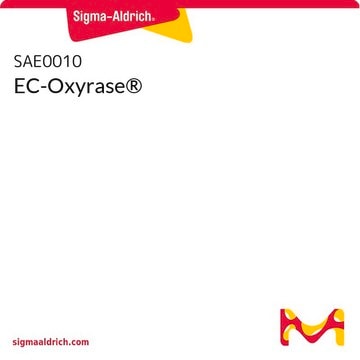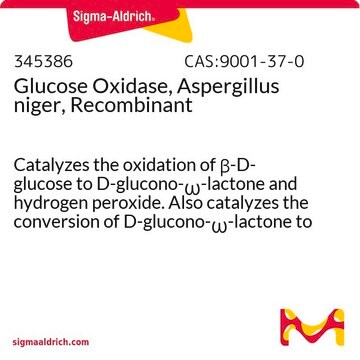P8279
Protocatechuat-3,4-Dioxygenase aus Pseudomonas sp.
lyophilized powder, ≥3 units/mg solid
Anmeldenzur Ansicht organisationsspezifischer und vertraglich vereinbarter Preise
Alle Fotos(7)
About This Item
CAS-Nummer:
MDL-Nummer:
UNSPSC-Code:
12352204
NACRES:
NA.54
Empfohlene Produkte
Biologische Quelle
bacterial (Pseudomonas spp.)
Form
lyophilized powder
Spezifische Aktivität
≥3 units/mg solid
Mol-Gew.
~700 kDa
Versandbedingung
dry ice
Lagertemp.
−20°C
Allgemeine Beschreibung
Protocatechuat-3,4-Dioxygenase gehört zur Enzymfamilie der Nicht-Hämeisen. Die aktive Stelle des Enzyms enthält Fe3+.
Anwendung
Das Enzym wird gemeinsam mit Protocatechuat (PCA) und Trolox als Sauerstoff-Fängersystem verwendet. Das Enzym basiert auf einem Nicht-Hämeisenzentrum, welches die Umwandlung von PCA und molekularem Sauerstoff in β-Carboxy-cis,cis-Muconsäure katalysiert, während das Antioxidans Trolox das langsame Blinken und die Photobleichung von Cyanin-Farbstoffen unterdrückt. Es wird gemeinsam mit DMB-BSA (Dynein-Motilitätspuffer-BSA), ATP und Protocatechuat im Einzelmolekül-Motilitätsassay für die Zubereitung von Bildgebungspuffern verwendet.
Protocatechuat-3,4-Dioxygenase (PCD) aus Pseudomonas sp. wird bei Bindung mit p-Hydroxybenzoat-Hydroxylase zur enzymatischen Bestimmung von Cholinesterase verwendet. Es wird zur Verbesserung der organischen Fluorophor-Stabilität in Einzelmolekül-Experimenten und zur Untersuchung des Metabolismus von Protocatechuat in Rhizobiaceae verwendet.
Biochem./physiol. Wirkung
Protocatechuat-3,4-Dioxygenase katalysiert den Abbau von 3,4-Dihydroxybenzoat (Protocatechuat) in β-Carboxy-cis,cis-Muconat.
Physikalische Eigenschaften
Struktur: Protein mit Nicht-Hämeisen
Inhibitoren: Ag+, Hg++, PCMB
Optimaler pH-Wert: 9,0
Optimale Temperatur: 60−65 °C
pH-Stabilität: pH 7,0−9,0 (25 °C, 72 h)
Wärmebeständigkeit: maximal 50 °C (pH 6,0, 1 h)
Inhibitoren: Ag+, Hg++, PCMB
Optimaler pH-Wert: 9,0
Optimale Temperatur: 60−65 °C
pH-Stabilität: pH 7,0−9,0 (25 °C, 72 h)
Wärmebeständigkeit: maximal 50 °C (pH 6,0, 1 h)
Einheitendefinition
Eine Einheit oxidiert 1,0 μmol Protocatechuat zu 3-Carboxy-cis,cis-Muconat pro min bei einem pH-Wert von 7,5 und 37 °C.
Physikalische Form
Wird als lyophilisiertes Pulver geliefert.
Hinweis zur Analyse
Proteinbestimmung durch Biuret.
Inhibitor
Produkt-Nr.
Beschreibung
Preisangaben
Lagerklassenschlüssel
11 - Combustible Solids
WGK
WGK 3
Flammpunkt (°F)
Not applicable
Flammpunkt (°C)
Not applicable
Persönliche Schutzausrüstung
Eyeshields, Gloves, type N95 (US)
Analysenzertifikate (COA)
Suchen Sie nach Analysenzertifikate (COA), indem Sie die Lot-/Chargennummer des Produkts eingeben. Lot- und Chargennummern sind auf dem Produktetikett hinter den Wörtern ‘Lot’ oder ‘Batch’ (Lot oder Charge) zu finden.
Besitzen Sie dieses Produkt bereits?
In der Dokumentenbibliothek finden Sie die Dokumentation zu den Produkten, die Sie kürzlich erworben haben.
Kunden haben sich ebenfalls angesehen
Colin Echeverría Aitken et al.
Biophysical journal, 94(5), 1826-1835 (2007-10-09)
The application of single-molecule fluorescence techniques to complex biological systems places demands on the performance of single fluorophores. We present an enzymatic oxygen scavenging system for improved dye stability in single-molecule experiments. We compared the previously described protocatechuic acid/protocatechuate-3,4-dioxygenase system
G Trautwein et al.
Journal of bacteriology, 183(3), 873-881 (2001-02-24)
Protocatechuate degradation is accomplished in a multistep inducible catabolic pathway in Acinetobacter sp. strain ADP1. The induction is brought about by the transcriptional regulator PcaU in concert with the inducer protocatechuate. PcaU, a member of the new IclR family of
G K Podila et al.
Applied and environmental microbiology, 59(8), 2717-2719 (1993-08-01)
A heterologous gene probe encoding the alpha and beta subunits of the Pseudomonas cepacia protocatechuate 3,4-dioxygenase (PCD) was used to detect its homolog in the genome of Bradyrhizobium japonicum USDA110. Three cosmid clones carrying a 2.2-kb BamHI insert showed high
Brevibacterium fuscum protocatechuate 3, 4-dioxygenase. Purification, crystallization, and characterization.
Whittaker J W, et al.
The Journal of Biological Chemistry, 259(7), 4466-4475 (1984)
M Contzen et al.
Molecular microbiology, 41(1), 199-205 (2001-07-17)
The genes for a protocatechuate 3,4-dioxygenase (P34O-II) with the ability to oxidize 4-sulphocatechol were cloned from the 4-aminobenzenesulphonate(sulphanilate)-degrading bacterium Hydrogenophaga intermedia strain S1 (DSMZ 5680). Sequence comparisons of the deduced amino acid sequences of both subunits of the P34O-II from
Unser Team von Wissenschaftlern verfügt über Erfahrung in allen Forschungsbereichen einschließlich Life Science, Materialwissenschaften, chemischer Synthese, Chromatographie, Analytik und vielen mehr..
Setzen Sie sich mit dem technischen Dienst in Verbindung.











